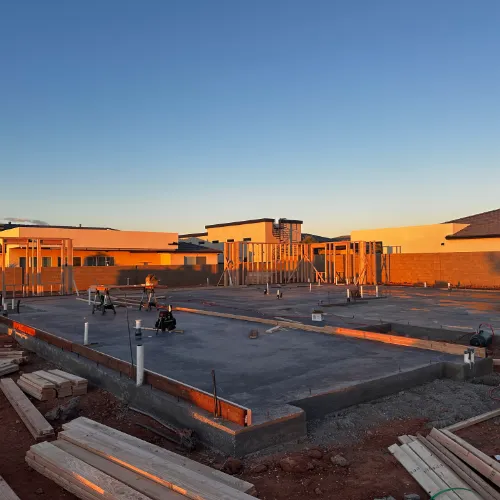When it comes to building a home or commercial structure, one of the first big decisions involves the type of framing material to use. The frame is the skeleton of the building. It defines its strength, shape, and durability. While there are multiple framing options available, the two most common are wood framing and steel framing.
So what’s the difference, and which one is right for your project? In this article, we’ll break down the key distinctions between wood and steel framing, the pros and cons of each, and how to decide which is the best choice for your needs.
Understanding Framing
Before we dive into materials, let’s quickly review what framing is. Framing refers to the structural framework of a building which is the system of studs, beams, joists, and rafters that support the walls, floors, and roof.
- Wood framing usually involves dimensional lumber like 2x4s or 2x6s.
- Steel framing uses light-gauge steel studs or, in some cases, heavier structural steel for larger buildings.
Both serve the same purpose but perform differently in terms of strength, durability, cost, and maintenance.
Wood Framing
Wood framing, often called “stick framing,” is the traditional method used in residential construction across North America. It’s been the standard for decades, and most builders are highly familiar with it.
Advantages of Wood Framing
- Cost-Effective: Wood is generally less expensive than steel, making it the budget-friendly choice.
- Readily Available: Lumber is easy to source almost anywhere.
- Ease of Use: Wood is simple to cut, nail, and adjust on-site. This flexibility helps with custom designs and quick modifications.
- Thermal Insulation: Wood naturally insulates better than steel, reducing energy transfer.
- Tradition: Most trades are experienced with wood-framed projects, reducing learning curves.
Disadvantages of Wood Framing
- Susceptible to Moisture: Wood can rot, warp, or swell if exposed to water.
- Pest Damage: Termites and other insects can cause significant issues.
- Fire Risk: Wood is combustible, requiring additional fire-resistant treatments in some areas.
- Sustainability Concerns: While lumber can be renewable, large-scale logging has environmental impacts.
Steel Framing
Steel framing has become increasingly popular, especially in commercial construction and modern residential builds. It uses galvanized steel studs instead of lumber, creating a sturdy, long-lasting structure.
Advantages of Steel Framing
- Strength and Durability: Steel doesn’t warp, twist, or shrink. It holds its shape over time.
- Pest and Rot Resistant: Termites, carpenter ants, and mold don’t affect steel.
- Fire Resistant: Steel is non-combustible, providing added safety.
- Sustainability: Steel is recyclable, and many framing studs are made from recycled material.
- Precision: Manufactured to exact dimensions, steel framing is highly consistent.
Disadvantages of Steel Framing
- Cost: Steel is generally more expensive upfront than wood.
- Thermal Conductivity: Steel transfers heat and cold easily, meaning extra insulation is often required.
- Specialized Tools: Steel framing requires different tools and skills, which can increase labor costs.
- Sound Transmission: Steel can transmit sound more than wood if not properly insulated.
Cost Comparison
One of the biggest considerations is cost.
- Wood Framing: Usually 10–20% cheaper than steel framing on material costs alone. Labor is also less expensive because most crews are trained in wood construction.
- Steel Framing: Higher upfront cost, but lower maintenance costs long-term. It’s less likely to require repairs due to pests, warping, or rot.
For smaller residential projects, wood often wins out on price. For large-scale or long-term builds, steel can offer better value.
Durability and Lifespan
Durability is where steel really shines.
- Wood: Can last for decades with proper maintenance but is vulnerable to environmental factors.
- Steel: Extremely durable, resistant to moisture, pests, and fire. It maintains its shape and integrity far longer than wood.
If long-term performance and minimal upkeep are top priorities, steel has the edge.
Sustainability
Both materials have environmental considerations:
- Wood: Renewable when sourced from responsibly managed forests. However, deforestation is a concern.
- Steel: Fully recyclable and often made from recycled content, though manufacturing steel is energy-intensive.
Choosing sustainably sourced lumber or recycled steel can reduce environmental impact either way.
Where Each Material Works Best
Wood Framing Works Best For:
- Single-family homes and smaller residential projects.
- Projects with tighter budgets.
- Designs requiring flexibility and on-site adjustments.
Steel Framing Works Best For:
- Commercial buildings or large-scale residential developments.
- Projects in areas with termites, high humidity, or fire risk.
- Modern designs with long spans or unique architectural features.
Hybrid Approaches
In some cases, builders use a hybrid system where you combine wood and steel framing. For example:
- Using steel for exterior walls (for durability) and wood for interior walls (for cost savings).
- Mixing materials in commercial-residential hybrid spaces (like condos with retail on the bottom floor).
This approach allows builders to balance cost, strength, and performance.
Making the Right Choice
So, how do you decide between wood and steel framing? Consider these questions:
- What’s your budget? If cost is the deciding factor, wood is generally more affordable.
- Where is the project located? High-moisture or termite-prone areas benefit from steel.
- What’s the size and scope? Large, multi-story projects often lean toward steel.
- What’s the design style? Steel allows for longer spans and modern architectural features.
- What are your long-term goals? If you want minimal maintenance, steel may be the better investment.
To Wrap Things Up
Both wood and steel framing have their place in construction. Wood framing is cost-effective, flexible, and ideal for most residential builds. Steel framing offers unmatched durability, resistance, and precision, making it a strong choice for larger or specialized projects.
At the end of the day, the right choice depends on your budget, project type, and long-term goals. By understanding the differences, you can make an informed decision that ensures your home or building stands strong for years to come.
